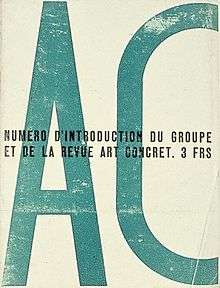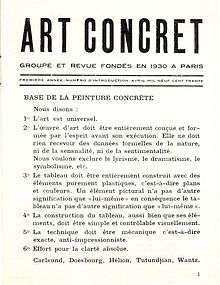Art Concret

Art Concret was an Avant-garde group of artists formed in Paris in 1929, championing a geometrical abstract art closely related to the aesthetics of Neo-plasticism. It consisted of Otto G. Carlsund, Theo van Doesburg, Jean Hélion, Marcel Wantz and Léon Arthur Tutundjian.
History
After the formal break up of De stijl, following the last issue of their magazine in 1928, van Doesburg began considering creating a new collective centered on a similar approach to abstraction. In 1929 he discussed his plans with Uruguayan painter Joaquín Torres-García, with candidates for membership of this group including Georges Vantongerloo, Constantin Brancusi, František Kupka, Piet Mondrian, Friedrich Vordemberge-Gildewart, Antoine Pevsner, Henri Nouveau, Louis Fernandez, among others. However, van Doesburg divided the candidates into two groups, consisting of 1) artists whose work was still not completely abstract, and 2) those who were. As this classification entailed the possibility of a disqualification of the first group, the discussions between the two soon broke down, prompting Torres-García to instead team up with Belgian artist Michel Seuphor and form the group Cercle et Carré.[1]

Following this, van Doesburg proceeded to propose a rivaling group, Art Concret, teaming up with artists Carlsund, Hélion, Wantz, and Tutundjian. They published the first (and only) issue of their own magazine Revue Art Concret in May 1930,[2] featuring their joint manifesto, positioning them as the more radical group of abstractionists, with aesthetic foundations formulated by van Doesburg that were "so absolutist that the majority of artists he approached transferred their allegiance to the opposing camp" of Seuphor and Torres-García’s Cercle et Carré.[3] "Their proclamation called for a universal art composed of planes and colours executed crisply, precisely, mechanically. Form and rhythm were governed by mathematical principles, while abstract cinema provided a model of combining space and time in a single work of art"[4]
The group became short lived and only exhibited together at three occasions in 1930 as part of larger group exhibitions, the first being at Salon des Surindépendents in June, followed by Production Paris 1930 in Zürich, and in August the exhibition AC: Internationell utställning av postkubistisk konst (International exhibition of post-cubist art) in Stockholm, curated by Carlsund. In the catalog to the latter, Carlsund states that the group's "programme is clear: absolute Purism. Neo-Plasticism, Purism and Constructivism combined".[5] Following van Doesburg's death in 1931, the Art Concret group united with the larger association Abstraction-Création, founded in 1932, though it was never formally dissolved.
Legacy
The groups' name Art Concret as well as its manifesto, The Basis of Concrete Painting, resulted in the establishment of the term "Concrete Art".
Notes and references
- ↑ Wintgens Hötte, Doris (2009) "Van Doesburg tackles the continent: passion, drive & calculation", in: Gladys Fabre & Doris Wintgens Hötte (red.): Van Doesburg & the International Avant-Garde: Constructing a New World, London, Tate Publishing, 2010, pp. 10-19.
- ↑ Numéro d'introduction du group et de la Revue Art Concret, Impr. Union, Paris, 1930.
- ↑ http://www.tate.org.uk/whats-on/tate-modern/exhibition/van-doesburg-and-international-avant-garde/van-doesburg-and-9
- ↑ http://www.tate.org.uk/whats-on/tate-modern/exhibition/van-doesburg-and-international-avant-garde/van-doesburg-and-9
- ↑ AC: Internationell utställning av postkubistisk konst, Stockholm, 1930, p.3
Further reading
- Gladys Fabre & Doris Wintgens Hötte (red.): Van Doesburg & the international avant-garde. Constructing a new world, London, Tate Publishing, 2010.
- Fogelström, Lollo (ed.): Otto G. Carlsund: konstnär, kritiker och utställningsarrangör, Liljevalchs konsthall, 2007.